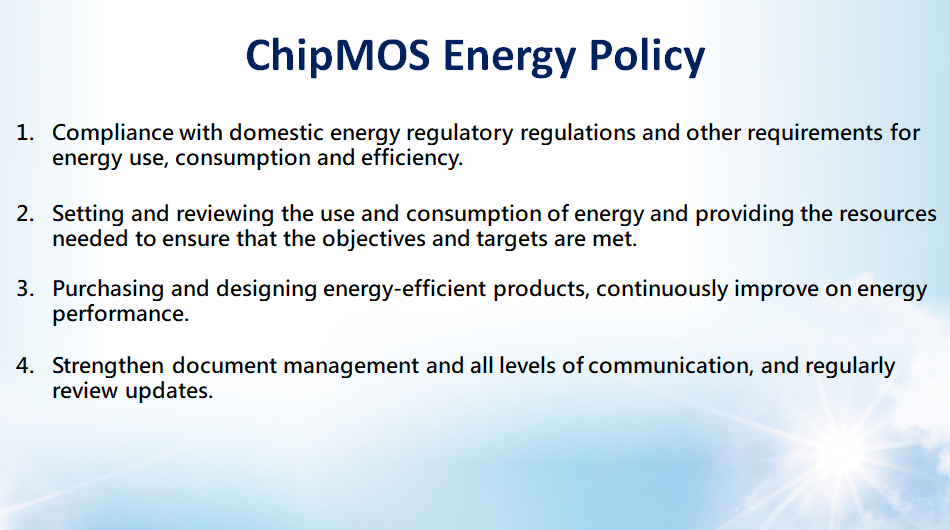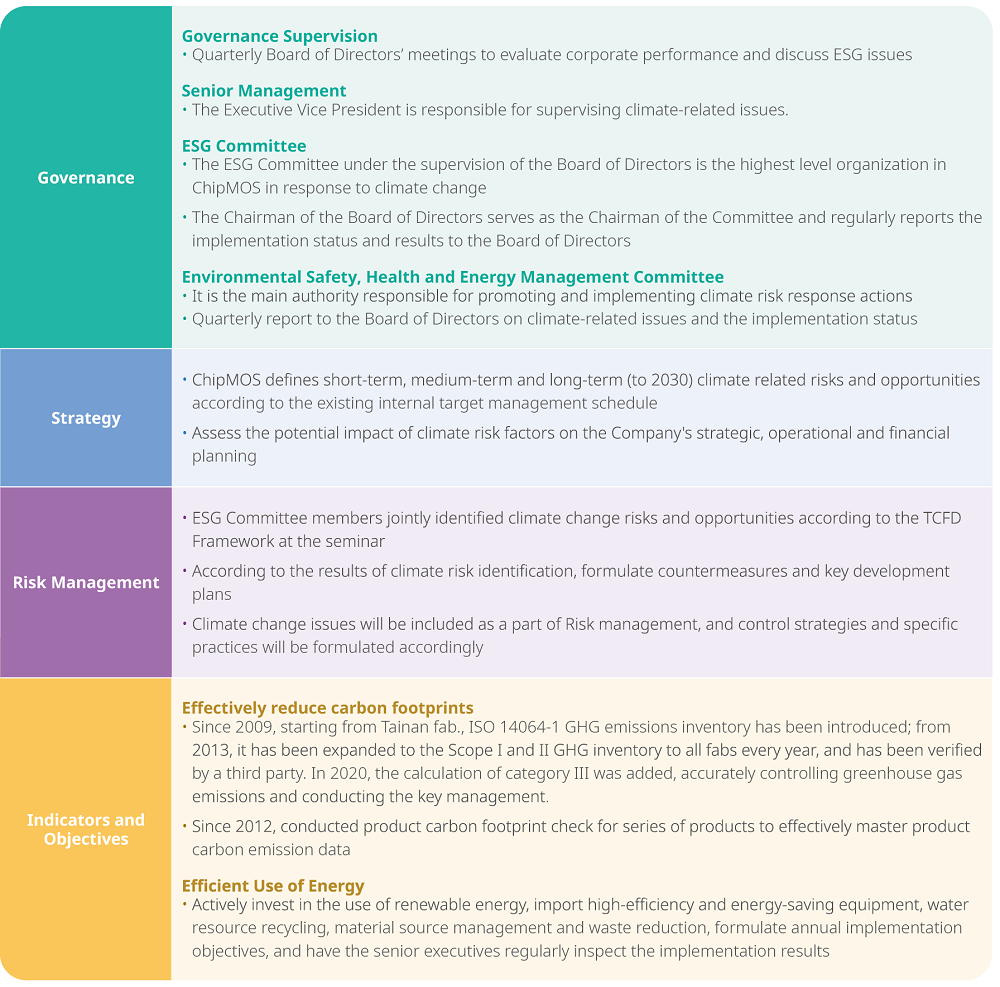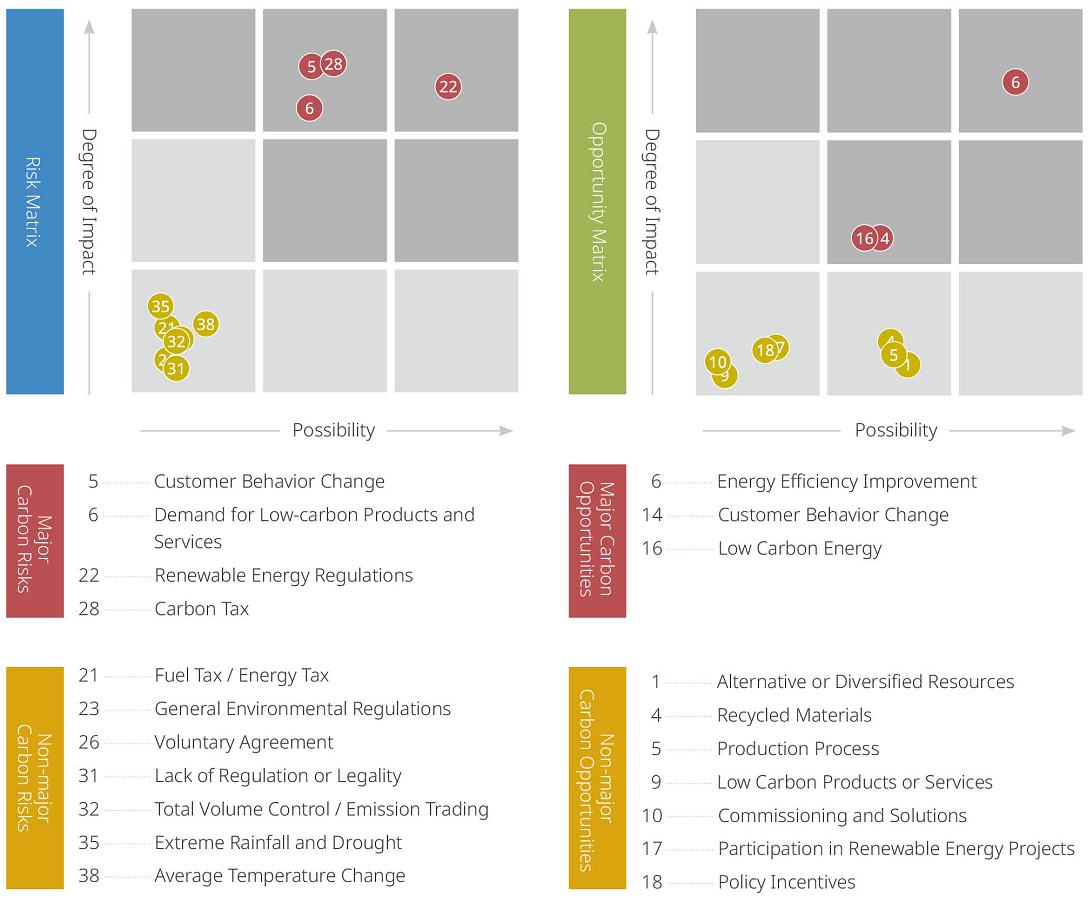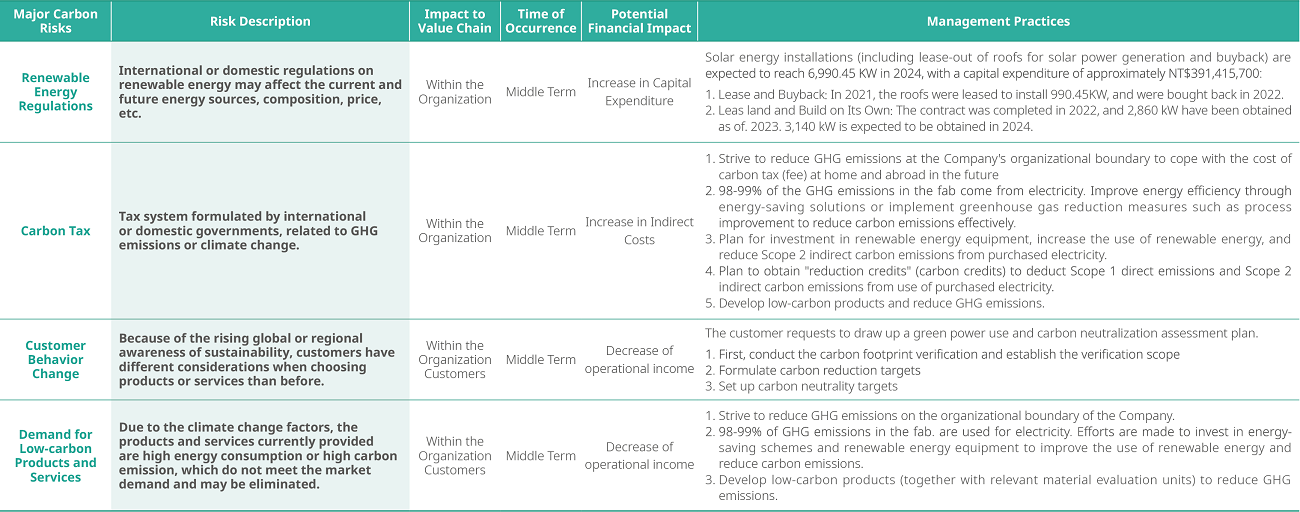Energy Management

Task Force on Climate-Related Financial Disclosures (TCFD)
Climate change has become a common challenge for global enterprises to promote sustainable development. To control the global warming within no more than 2 ºC and affect the opportunities and risks implied in enterprise capacity expansion and market opportunities are the challenges that enterprises must face up to and prepare in advance. ChipMOS is well aware of the importance of corporate action and shoulders the heavy responsibility of environmental protection. We refer to the framework of the Task Force on Climate-related Financial Disclosures (TCFD) issued by the Financial Stability Board (FSB), identify the management of ChipMOS climate change risks and opportunities, and further have a comprehensive understanding of the impact of climate change.
▼TCFD Framework

Identification of Climate Risk / Opportunity
In 2024, our ESG Committee reviewed and affirmed the climate change risk and opportunity assessment from 2021. We plan to enhance this analysis and identification in 2025. Guided by the TCFD framework, our assessment covers both transition and physical risks. We've categorized risks into regulatory, market/technological and operational disruption. This includes 48 carbon risk items (4 major, 7 moderate) and 21 carbon opportunity items (3 major, 7 moderate), totaling 69 items. We prioritized these based on potential impact timing (short, medium, long-term) and severity factors (financial, operational/human resources, legal, reputational). This process identified 4 major carbon risks and 3 major carbon opportunities, for a total of 7 significant items. We've assessed their potential financial impact and are developing strategies to mitigate risks and capitalize on future business opportunities.



GHG Inventory
ChipMOS actively responds to the global trend of carbon reduction, brings mitigation and adaptation of climate change into important issues in operation management, and sets the Environmental Safety, Health and Energy Management Committee as the authority and responsibility function to promote carbon management issues. Since 2009, each fab has independently implemented inventory, established a GHG inventory lists, and identified key GHG emissions sources in the production process for management. We conduct verification every year in accordance with ISO 14064-1 to ensure data quality and provide credible carbon management information to stakeholders.
In 2024, ChipMOS GHG emissions (Scope 1 + Scope 2) were about 249,924.67 tCO2e; relevant analyses showed that 98.44% were Scope 2 emissions generated by purchased electricity, while Scope 1 emissions accounted for about 1.56% of the total emissions, mainly from the leakage of hydrofluorocarbons (HFCs) used in refrigerants at each fab, totaling 2,685.2 tCO2e. In response to the Montreal Protocol - Kigali Amendment and Taiwan's Hydrofluorocarbon Management Regulations, future purchases of refrigerant-related equipment will no longer include listed hydrofluorocarbons, gradually reducing relevant use. No perfluorinated compounds (PFCs) were used by the fabs. In light of ChipMOS emission structure, an energy-saving team has been established internally, to actively conduct energy-saving and carbon reduction management programs for various energy-consuming equipment.
Since 2021, we have taken the initiative to add Category 3 and Category 4 verification in accordance with ISO 14064-1:2018, prepared for the IFRS requirements in advance. We gradually expand inventory scope in stages, 2023 added "Capital Goods" and "The Use of Asset" under Category 4, 2024 added "Investments" under Category 5. It help ChipMOS more accurately find the sources of carbon emissions and actively promote decarbonization actions. Emission of Categories 3 to 6 in 2024 were 105,286.77 tCO2e.
In addition to continuously optimizing the consolidated routes of employee shuttle buses, ChipMOS plans to implement a carpooling measure for business trips in 2025, with regular weekly round-trip shuttle buses between the Tainan fab and THSR Tainan Station, encouraging employees to practice energy-saving and carbon reduction from their daily lives, reducing fuel consumption and air pollution caused by transportation tools.
Energy Management and Efficiency
Due to the characteristics of the technology manufacturing industry, ChipMOS is one of the major power-consuming enterprises regulated by the Bureau of Energy under the Ministry of Economic Affairs. Since 2012, ChipMOS has been committed to a rigorous and energy-saving attitude towards energy use, continuously introducing various energy-saving technologies and equipment. In 2014 and 2017, it voluntarily introduced ISO 50001 energy management system certification in its Tainan plant and Hsinchu plant, respectively. To further enhance the accuracy and implementation of energy management measures at each plant, ChipMOS plans to introduce ISO 50001 verification for its Zhubei plant and Hukou plant by 2025, accurately identifying major power-consuming equipment through energy audits and implementing various energy-saving initiatives based on audit results.
In 2024, the electricity saving rate reached 3.94%, continuously expanding the integration of energy-saving production equipment, with a 1.17% increase in electricity saving rate compared to 2023.
In 2024, ChipMOS energy-saving team will continue to communicate and cooperate across departments, constantly improving their energy-saving and carbon-reducing actions. The main categories of these efforts include: reducing the consumption of equipment and resources, smart energy-saving measures, lighting energy-saving, and optimizing operating conditions; not only will they carry forward the most effective power-saving initiatives from 2023, but also continue to upgrade old equipment and optimize operational parameters. ChipMOS energy-saving scope extends to production equipment at factory sites, fully covering all company devices with specific measures such CDA reduction optimization for factory-side machines, parameter adjustments, and smart control, achieving full employee participation in energy-saving actions and effectively implementing energy management goals during operations.
Green Energy Planning
The purchased electricity used in the manufacturing process is the most important source of our overall carbon footprint. Therefore, we are committed to reducing the generation of purchased electricity and prioritizing internal energy-saving management measures for carbon reduction, supplemented by investment in renewable energy to actively achieve net zero transition. In terms of green energy input, ChipMOS mainly focuses on solar power installation and purchasing renewable energy certificates. Since 2012, ChipMOS has been installing rooftop solar panels at its southern and northern factory areas and signing a contract with Taipower for the transfer of green electricity. Besides building rooftop solar panels in self-owned fabs, we also increase the proportion of renewable energy usage by leasing land to build solar power stations. These stations are located throughout northern, central, southern, and eastern regions in Taiwan. By the end of 2024, the total installed capacity of solar power reached 7,206.15 kW. Over the past 13 years, the accumulated solar power generation has reached up to 12,961,733 kWh, which can satisfy the monthly electricity consumption of nearly 38,348 households (Note 1). In terms of purchasing renewable energy certificates, ChipMOS purchased a total of 2,840 certificates in 2024, accounting for 0.57% of its total energy usage that year, representing an increase of about 167 times compared to the renewable energy ratio in 2023.
To actively achieve the carbon reduction goal, ChipMOS green energy development plan will focus on self-generated and self-consumed solar power. It is expected that by 2025, the total capacity of its own solar power stations for self-generation and self-consumption will reach 5,124.95 kW, with an estimated annual electricity generation of approximately 6,222 kWh, accounting for about 1.26% (Note 2) of the total energy consumption. In the future, it will continue to evaluate the possibility of purchasing and developing other green energy sources to realize more ambitious reduction targets.
Note 1: Calculated based on the average monthly power consumption of 338 per household in 2023 announced by the Ministry of Economic Affairs official website
Note 2: Calculated using the electricity consumption data for the base year of 2021.